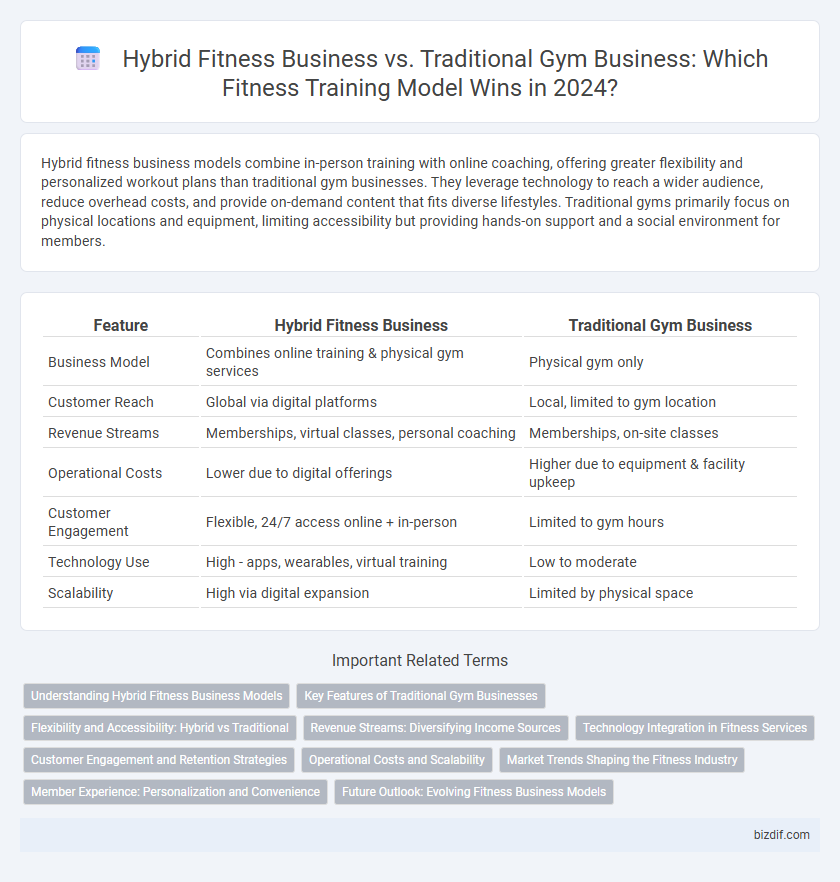Hybrid fitness business models combine in-person training with online coaching, offering greater flexibility and personalized workout plans than traditional gym businesses. They leverage technology to reach a wider audience, reduce overhead costs, and provide on-demand content that fits diverse lifestyles. Traditional gyms primarily focus on physical locations and equipment, limiting accessibility but providing hands-on support and a social environment for members.
Table of Comparison
| Feature | Hybrid Fitness Business | Traditional Gym Business |
|---|---|---|
| Business Model | Combines online training & physical gym services | Physical gym only |
| Customer Reach | Global via digital platforms | Local, limited to gym location |
| Revenue Streams | Memberships, virtual classes, personal coaching | Memberships, on-site classes |
| Operational Costs | Lower due to digital offerings | Higher due to equipment & facility upkeep |
| Customer Engagement | Flexible, 24/7 access online + in-person | Limited to gym hours |
| Technology Use | High - apps, wearables, virtual training | Low to moderate |
| Scalability | High via digital expansion | Limited by physical space |
Understanding Hybrid Fitness Business Models
Hybrid fitness business models combine in-person training with digital platforms, offering clients flexible workout options and personalized coaching through apps, live streams, and on-demand content. This approach leverages technology to track progress, enhance member engagement, and broaden the customer base beyond the local gym's geographic limits. Hybrid models optimize revenue streams by integrating subscription services, virtual classes, and physical memberships, creating a scalable and adaptable fitness ecosystem.
Key Features of Traditional Gym Businesses
Traditional gym businesses offer fixed-location facilities equipped with standard exercise machines, free weights, and group classes, catering to in-person workout sessions. These gyms rely heavily on membership subscriptions, providing access to amenities like locker rooms, personal training, and scheduled fitness programs. The key features emphasize physical presence, consistent operational hours, and a community environment for motivation and support.
Flexibility and Accessibility: Hybrid vs Traditional
Hybrid fitness businesses offer enhanced flexibility by combining virtual classes with in-person sessions, allowing clients to train anytime and anywhere. Traditional gyms require physical presence, limiting accessibility for members with busy schedules or remote locations. This hybrid model caters to diverse lifestyles, increasing customer retention and broadening market reach.
Revenue Streams: Diversifying Income Sources
Hybrid fitness businesses generate revenue from diverse streams such as in-person classes, virtual training sessions, personalized coaching, merchandise sales, and digital content subscriptions, creating multiple income avenues. Traditional gyms primarily rely on membership fees and in-facility services, limiting income diversification. Expanding revenue streams through hybrid models enhances financial stability and growth potential in the competitive fitness industry.
Technology Integration in Fitness Services
Hybrid fitness businesses leverage advanced technology such as virtual training platforms, AI-driven workout personalization, and wearable device integration to enhance user engagement and optimize performance tracking. Traditional gyms often rely on physical equipment and in-person coaching, limiting remote access and real-time data analytics. Technology integration in hybrid models enables scalable, data-driven fitness solutions that cater to both in-gym and at-home clients, offering a competitive edge in customer retention and service innovation.
Customer Engagement and Retention Strategies
Hybrid fitness businesses leverage digital platforms and in-person training to create personalized workout experiences, enhancing customer engagement through app-based tracking, virtual classes, and flexible scheduling. Traditional gyms typically rely on physical presence and on-site services, requiring more frequent face-to-face interaction to maintain member motivation and loyalty. By integrating technology with physical access, hybrid models achieve higher retention rates through continuous engagement and adaptable fitness options.
Operational Costs and Scalability
Hybrid fitness businesses reduce operational costs by combining virtual and physical training sessions, lowering expenses related to facility maintenance and staff. Traditional gyms require significant investments in large physical spaces, equipment upkeep, and on-site personnel, limiting scalability. The hybrid model leverages digital platforms to reach a wider audience with minimal incremental costs, enabling faster expansion compared to conventional gym setups.
Market Trends Shaping the Fitness Industry
Hybrid fitness businesses are rapidly gaining market share by integrating digital platforms with in-person training, catering to consumer demand for flexibility and personalized experiences. Data from industry reports indicate a 30% annual growth in virtual fitness subscriptions, reflecting the rise in remote workouts and app-based coaching. Traditional gyms face challenges adapting to these trends, necessitating innovation in service delivery to maintain competitive relevance.
Member Experience: Personalization and Convenience
Hybrid fitness businesses enhance member experience through personalized training plans combining in-person sessions with digital resources, offering flexibility and tailored progress tracking. Traditional gyms primarily rely on on-site services with limited customization, which can limit convenience for members with busy schedules. Emphasizing convenience and personalization, hybrid models increase engagement and retention by integrating technology-driven solutions with expert coaching.
Future Outlook: Evolving Fitness Business Models
Hybrid fitness businesses integrate digital platforms with physical training spaces, offering personalized workout plans and virtual coaching that cater to diverse client needs. This model leverages technology for real-time progress tracking and scalable membership options, driving increased user engagement and retention. Traditional gym businesses face challenges adapting to these evolving demands but can benefit from incorporating hybrid elements to remain competitive in the rapidly growing fitness market.
Hybrid Fitness Business vs Traditional Gym Business Infographic

 bizdif.com
bizdif.com